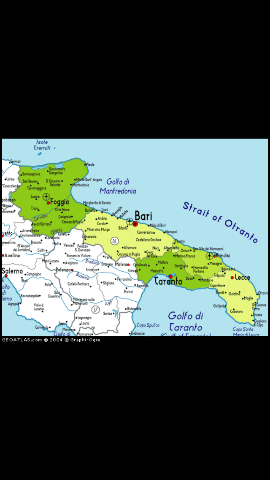Primitivo Di Manduria: Puglia's Wine
The Land And Sea Of Puglia
By: Philip S.Kampe - Oct 21, 2018
What traveler wouldn’t want to visit Rome, Florence or Venice? Beauty, architecture, fine art and food are all part of the adventure.
With twenty provinces and cities a bit off the beaten path, Sienna, Bologna, Naples, Reggio Calabra, Perugia and exotic islands like Capri and Sicily, it is hard to think that some of the areas that you miss on your overseas journey are the areas that stand out, both inmemory and gastronomic make-up.
There are areas where olive trees, some 800 years old and wines made for thousands of years prevail. The province that I am thinking of specifically is in the heel or so-called boot of Italy. The province has 325 miles of coastline, more olive trees then people and is a sea away from Albania and Greece.
By now you should have guessed that Puglia is the province that I am making reference to.
Puglia is known worldwide for a specific red wine from the area near Manduria. Primitivo di Manduria is the shining star of the province. The well known sweet version of the wine is Primitivo di Madutia Dolce Naturale, was Puglia’s first DOCG.
Primitivo, known as Zinfandel in California arrived into Italy originally from Croatia. Maduria is Primitivo’s spiritual home and the only viticultural area in Italy to specialize in the varietal.
Prior to visiting Puglia I posted an article discussing the wines from Puglia. If you missed the article, this is a recap.
Puglia has three specific winemaking regions. To the north is Castel del Monte DOP, to the south is Salice Salentino DOP and in the center of those two and the area this article will focus on is Primitivo di Manduria DOP. This area is in the heart of the Magna Grecia region that comprises many towns in the province of Taranto, of which the best known is Manduria, whose namesake is used in the name of Primitivo di Manduria,
Manduria is also home of the Cooperative Winegrowers Association of Manduria, which began in 1932 and Fulvio Filo Schiavoni, known as the ‘father of Primitivo di Manduria,’
Recently I had the opportunity to dine with the legend at the Museum of Primitivo Wine (Museo della Civilta del Vino Primitivo Manduria). Mr. Schiavoni explained the history of Primitivo and his mission at the museum.
The Museum of the Primitivo di Manduria culture was created to make the public aware of the people and objects that molded the history of wines from Manduria. The museum is a fascinating journey divided into more than thirty settings in ancient underground cisterns of a 19th century cellar that has been transformed.
The museum is what Manduria is about-wine tasting and sales, traditional gastronomic delights and an interactive historical wine museum. It is not to be missed.
The Museum of Primitivo Wine (Museum della Civilta del Vino Primitivo) is located on Via Fabbio Massimo 74024 in Manduria.
Telephone +39 099 9735332 or visit the website: www.museodelprimitivo.it
The President of the Consorzio for the Safeguard of Primitivo di Manduria, Roberto Erario, addressed those participants of the ‘Feel the Heel’ tour.
Mr. Erario, also a wine producer, wanted us to discover the natural and human factors that identify the terroir of Manduria and to discover the passion the land brings with its protected pedrocliamtic conditions and ancient wine traditions. Primitivo di Manduria thrives in this area.
Primitivo, like Tempranillo, share similar qualities and names because both names have to do with the varietal ‘repining early.’ The dark skins of the grapes produce tannic wines of deep, intense colors, which need several years in the barrel or bottle before becoming approachable. The hot, dry conditions coupled with plains that slope down to the sea are representative of Puglia’s terroir. The grapes are cultivated by an ancient technique called the ‘alberello method.’ The varietals grow on three branches and cannot exceed five feet in length.
The warm growing conditions in southern Puglia coupled with Primitivo di Manduria’s DOC 100% Primitivo grape rule help characterize the unusually high alcohol by volume percentage-usually above 14%. Notes of spice and plum coupled with rustic earth notes help create an old world wine with tame, not jammy, fruits.
It’s hard not to love the wines from Puglia. They have their own character and style. There are no favorites, just a group of vineyards who actively produce some of the best wines from the region.
To begin your journey to ‘Feel the Heel’ of Puglia, please try any of these producers and send me an email what you think about these producers and their wines.
Campa Erminio Vitcoltore www.erminiocampa.it
Cantolio Manduria www.cantolio.it
Cantine San Giorgio www.tinazzi.it
Masseria Cuturi www.masseriacuturi.it
San Marzano Vini www.sanmarzanowines.com
Peoduttori Di Manduria www.opvini.com
Masca Del Tacco www.mascadeltacco.com
Cantine Paolo Leo www.paololeo.it |
Cantine Erario www.agricolaerario.it
Bosco Societa Cooperativa Agricola www.vinibosco.it




